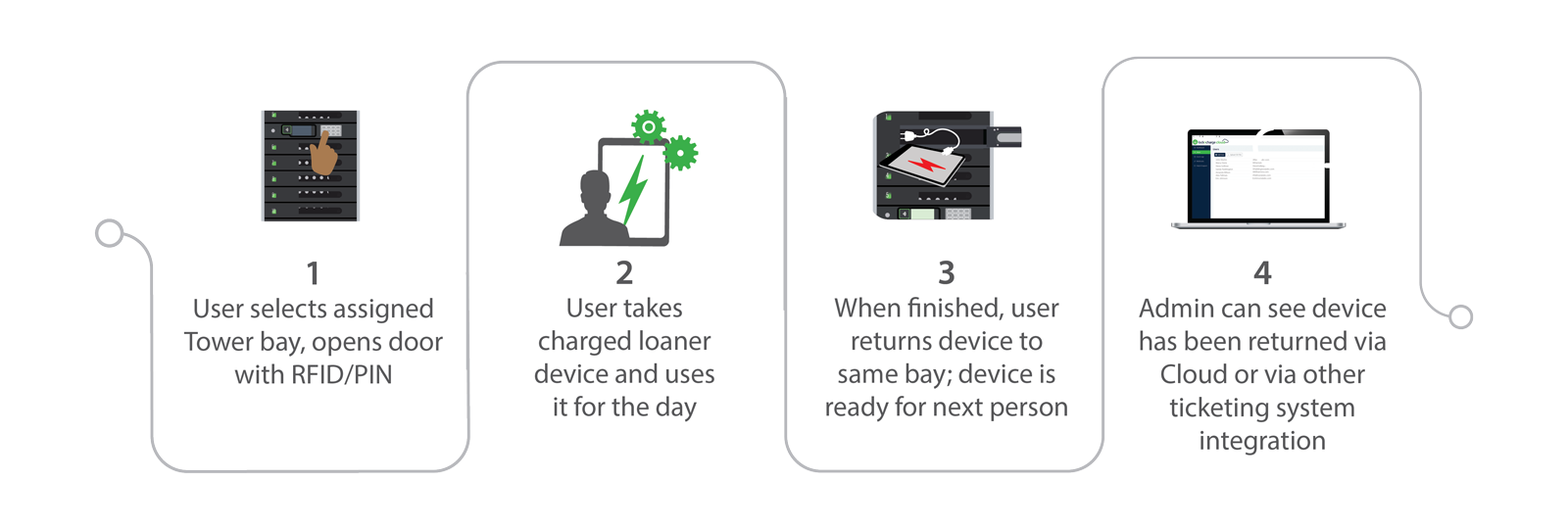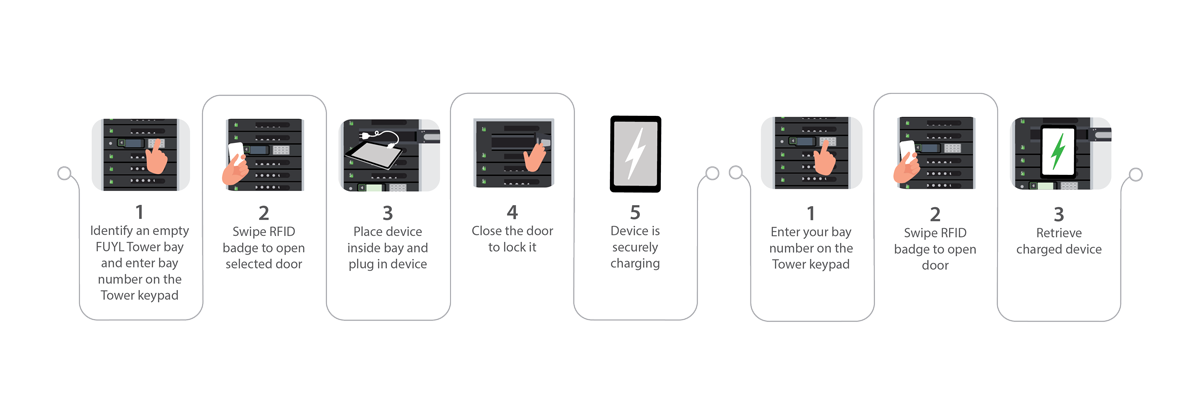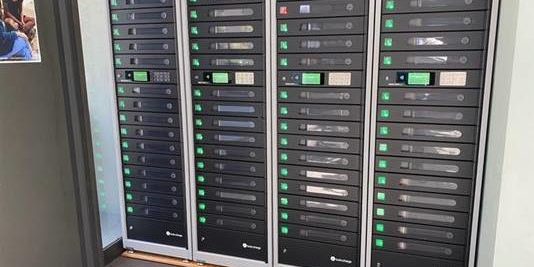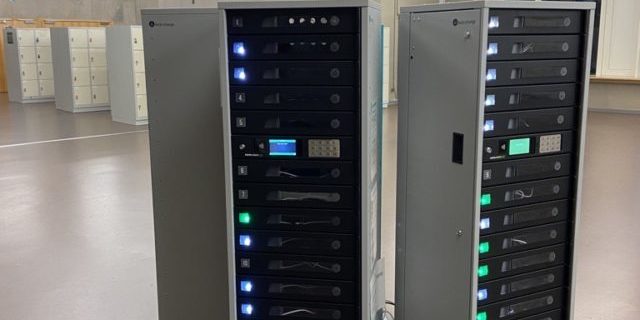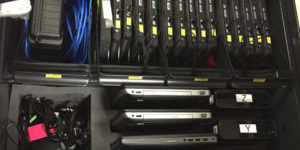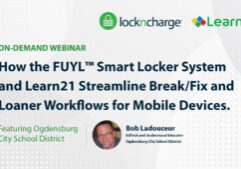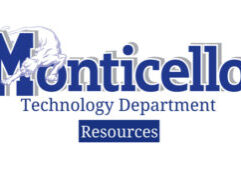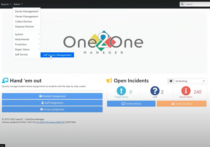Device Management for Schools: Take-Home Device Program Solutions
In recent years, many schools have focused on adopting technology at a rapid pace. The ambitious goal to connect students with the tech to help them succeed was accelerated by the COVID-19 pandemic, where it became a lifeline in facilitating remote education.
1-to-1 Device Program Stats for US Schools as of March 2021
A March 2021 survey by the EdWeek Research Center found that 90 percent of US educators said there was at least one device for every middle and high schooler. An additional 84 percent of educators said the same about elementary school students. Needless to say, schools have invested “a lot” in mobile device programs over the last few years.
The Wake County School District in North Carolina is one example. The district was in the process of updating to a 1-to-1 model in which every student would have access to their own individual device, but the transition to remote learning in 2020 meant they quickly spent $48 million on new devices.
Today’s students have grown up with technology woven into all facets of their lives. In order to keep up with the continued demand for technology in the curriculum, it has now become standard practice for many schools to allow their students to take devices home for schoolwork.
At its surface, a 1-to-1 program is a great solution for schools across the board. After all, allowing students to take home school-owned devices ensures they have equitable access to their work and that they are always working with a device they are familiar with. When students are allowed to take school devices home, it helps bridge the gap between learning at school and learning at home. Nothing beats that, right?
However, teachers and other school administrators know that letting students take devices home also comes with challenges, too. Here we discuss those challenges as well as proven solutions to make 1-to-1 take-home models more efficient for students and less burdensome on school staff.
Challenge #1: Forgotten Devices
“I left my homework at home.” Prior to services like Google Classroom, those six words were the bane of almost every teacher’s existence. Now, imagine if you replaced “homework” with “curriculum.” Students who forget their device at home are not able to participate in lessons that require the use of a device – which puts them a day behind in classwork.
Let’s be honest, students are notoriously forgetful. And between calling Mom or Dad to deliver the device, and missing out on classwork, a forgotten device can be a serious distraction to students and teachers for an entire day.
Solution: Implement a Streamlined Device Loaner Program
Get a device back in the hands of the student faster – and save your tech teams serious time – by implementing an on-site device loaner program. By filling a secure FUYL Tower Smart Charging Locker System with loaner devices at each school location, students can enter a 4-digit PIN or scan an RFID badge to check out a loaner device with minimal faculty oversight.
The only time taken from an IT member’s or a media specialist’s day is providing the PIN or RFID access. This process can be automated even further by integrating an external ticketing system with LocknCharge Cloud.
The best part of all? The student is able to get back to class – and back to learning – without missing a beat.
Challenge #2: Dead Devices
Remember those forgetful students we mentioned? They’re probably going to forget to charge their devices before coming to class, too. Similar to showing up with no device, a dead laptop or tablet has the same capacity to disrupt learning time.
“You don’t always think about charging as a problem until you see the things students do to charge their devices throughout the day,” said Kim Bannigan, a learning information systems coordinator at DeForest Area School District. “Kids were leaving devices wherever there was an open outlet. At one point, an outlet in the cafeteria was being used so frequently that it disrupted the lunch line.”
-Kim Bannigan, Administrator at DeForest Area School District in Wisconsin
With limited outlets in the classroom, cafeteria, or media center, students are probably going to play a game of limbo all day long – struggling to find an outlet, only to leave their devices unattended while charging.
Solution: Enable Secure Charging Locations for Students
Allow students to securely charge their devices on demand by installing a FUYL Smart Locker System in a public area of the school. By empowering students to securely charge their devices during the day, schools are teaching students to take ownership of their devices while decreasing the costs of their device programs.
Read these case studies to learn more about on-demand public charging in schools
Sorry, we couldn't find any posts. Please try a different search.
Challenge: #3 Broken Devices
One of the top frustrations of IT staff is that they have more work than they're able to handle. Whether it be general software maintenance or broken hardware, it’s inevitable that student devices will need some kind of repair during the school year.
For tech teams and media specialists that are already strapped for resources, imagine the additional time that is wasted running around collecting broken devices. If 20% of devices go missing or are broken each year across multiple school locations, the burden can quickly compound.
Solution: Automate Your Break/Fix Program with a Smart Locker
Save your tech team serious time by implementing a FUYL Smart Charging Locker System to facilitate broken device exchanges. By designating a smart locker (such as the FUYL Tower) as a device repair drop point, school staff members no longer need to waste their valuable time tracking down and collecting broken devices.
Once a student reports that their device is in need of attention, a staff member can assign that student to a specific locker. Using an admin-defined PIN or an RFID card, the student can either drop their device in an empty slot or swap their broken device for a ready-to-use one. Once their device is fixed, they simply return to a smart charging locker to swap their loaner device for the original device.
BONUS FEATURE OF A SMART LOCKER FOR DEVICE MANAGEMENT IN SCHOOLS:
Admins can monitor and record activity of the smart charging locker, which automates the need for extra human capital to track the whereabouts of a device at any given time. A smart locker system can automate manual tasks that once required human touch for a fraction of the cost.
Challenge #4: Summer Vacation
Summer vacation is just around the corner, and suddenly you’re scrambling, trying to figure out where you are going to store all these devices this summer. Plus, you’re having nightmares that tablets and laptops aren’t going to be charged when school starts back up. And on top of that, you’re already stressed about the chaos that will ensue when devices need to be redistributed at the beginning of the year.
Solution for Storage: Invest in an Open-Concept Charging Cart with Baskets
Many schools are investing in open-concept charging carts with baskets that have the ability to securely store, charge and transport large numbers of laptops, tablets and other technology when not in use. By placing the devices in baskets, devices are easily loaded and unloaded into a cart, allowing them to be charged in batches with ease.
In addition to mobile devices, open-concept carts can flex to accommodate robotics, 3D printers, VR goggles and more. Plus, as tablet and laptop technology in schools evolves, these types of universal charging stations will not become outdated.
Solution for Charging: Find a Charging Solution That Features ECO Safe Charge
Alright, so you’ve solved the issue of storage … now onto those dead batteries. Finding a spot to charge tens, hundreds or even thousands of devices at once can be daunting. It can also put serious strain on a school building’s electrical capabilities.
To efficiently charge greater numbers of devices while reducing the possibility of a general electrical overload to an outlet, power management inside of a charging cart is key. Features like “safe on/off”, “ECO Timer All” and “ECO Timer Cycle” are imperative to a smooth transition from summer to the first day of school. Click here for a quick guide to getting devices ready for the new school year.
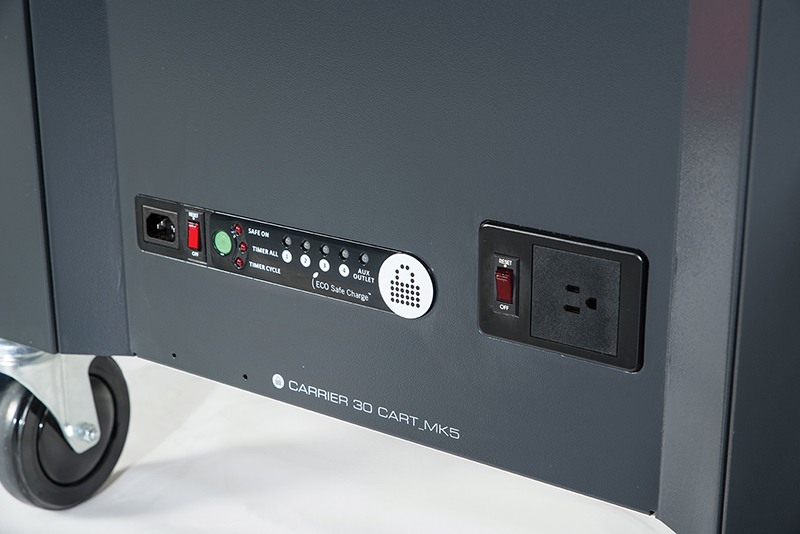
Solution for Distribution: Use Distribution Tools Such as Time-Saving Baskets
The final hurdle is redistribution of devices. The answer? Time-Saving Baskets and FUYL Tower Smart Lockers. Quickly and easily transport and distribute devices throughout your school with hand-held device baskets, designed so you can safely carry 5 devices in each hand. You can see how schools are using baskets to cut down on device distribution time here:
To seamlessly onboard teachers, or perhaps new students entering your district mid-year, use a FUYL Tower to deploy devices with far fewer headaches. Just place the towers in an accessible location, and stock them with a ready-to-go device in each bay. When a teacher or student needs a device, they’re assigned a tower bay and can access a device at their convenience. There’s no need to schedule pick-ups and drop-offs or even engage in face-to-face interaction, leaving your IT team more time to focus on other tasks.
Read this case study to learn more about using a Smart Locker for contactless device distribution in schools.
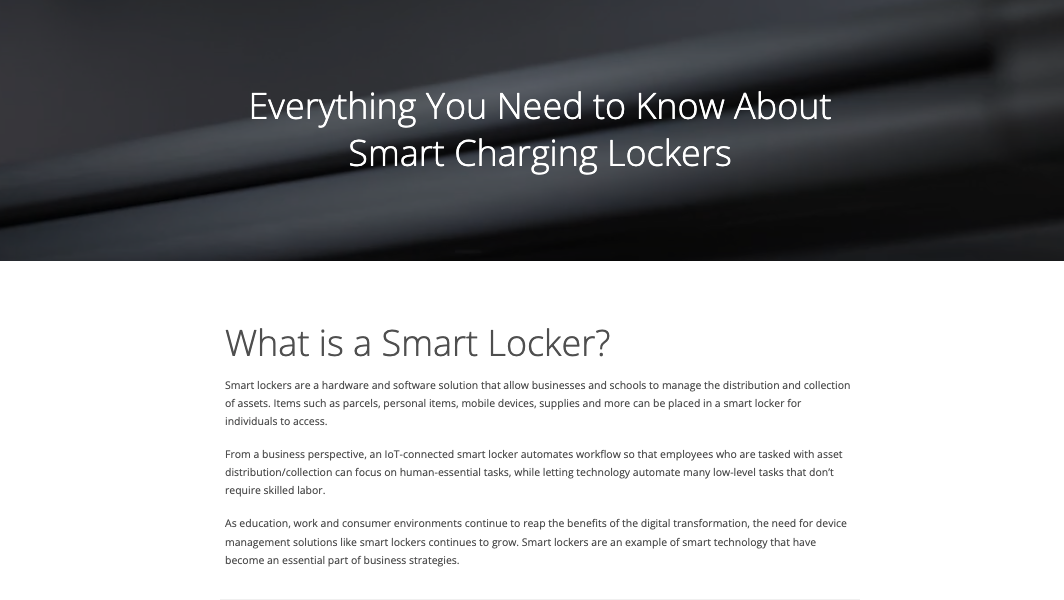
Everything You Need to Know About Smart Charging Lockers
Take a deep dive into this article about Smart Lockers to better understand their value, workflows, features and more.
5 Smart School Tech Investments – and Why Smart Lockers Top the List
1-to-1 student device programs are becoming the norm for many school districts, and investing in support for technology is no longer optional. A March 2021 survey by the EdWeek Research Center found that 90 percent of US educators said there was at least one device for every middle and high schooler. An additional 84 percent said the same about elementary school students.
It’s more important than ever that schools fully support the digital tools that enhance learning outcomes for students. Here are a few ideas for smart investments that will make the best use of limited resources.

1. Invest in Future-Proof Technology
"Future-proof" does not simply mean something will last forever – but rather, that will provide value well into the future. So even as technology advances, future-proof charging solutions are able to evolve to meet your ever-changing needs.
On average, mobile devices in schools are refreshed every 3 to 5 years. It’s important to consider the amount of time and energy expended every time you go back to the drawing board to re-evaluate your technology stack. Imagine the resources your district would save if you didn’t need to replace your charging solutions every time your mobile devices are updated.
Consider investing in a future-proof Joey Cart or Carrier Charging Station by LocknCharge. These solutions combine universal charging, open-concept designs and durable hardware, that will meet your needs for years to come.
Using smart technology, such as smart lockers for schools, is also an investment that will save considerable time and resources long term. The FUYL Smart Locker System, for example, keeps devices secure and charged in individually-lockable bays while Admins remotely control user access through a cloud-based portal.
The FUYL Smart Locker System offers workflow flexibility so that schools can support automated broken device exchanges, no-contact loaner device check out, and secure, public charging on demand. Because LocknCharge Cloud is supported by an agile, in-house software development team, schools can be confident that the Cloud platform is supported at every turn. New, customer-centric features are added on a weekly basis, and industry-standard cyber security measures are always in place.
2. Explore Low-Cost, High-Value Solutions for Modernization
iPads and laptops enhance student learning, but millions of classroom devices lose their charge in schools every day. The obvious solution is to plug those devices into any available wall outlet. However, access to outlets may be limited and plugging too many devices into one outlet can cause a general electrical overload. Not to mention, devices that are charging on a counter or floor are not protected against breakage or theft.
Consider investing in technologies that modernize your school's infrastructure without costly facility upgrades. For example, the high-capacity Revolution 32 Cabinet eliminates the expense of installing new outlets. The station’s ECO Safe Charge™ Power Management System reduces the possibility of blowing a circuit when as many as 32 laptops are plugged in to a single outlet.
Vauban, a private education institution in Luxembourg, utilized FUYL Towers to support their approach to digital learning and to modernize their facility. At Vauban, each student takes ownership of their iPad containing digital textbooks. FUYL Towers promotes accountability for students by offering a secure place to charge a device during the day, keeping them on track in their classwork.
3. Consider Security Improvements
Did you know that between 2005 and 2020, US schools have lost 24.5 million records due to data breaches? Would it surprise you to find out that a sizable number of those breaches were caused by unintentional disclosures or theft/loss of portable devices?
A smart end-of-year budget investment is one that protects against data security breaches, costly device deployment setbacks and inefficient device downtime.
Implementing durable, secure charging stations and smart lockers for schools will physically protect devices and the data that's on them – not to mention decrease costs of lost hardware.
Plus, using a FUYL Tower to automate manual processes for managing mobile devices will free up tech team’s time so they can focus on upgrading network security and protecting student data from cyber attacks.
4. Support Teachers With Time-Saving Tools
With limited educational resources, a smart investment also includes a strategy to deploy valuable tools and resources to the people who need them most.
Ideally, your plan should support teachers by saving them valuable classroom time. For example, one cabinet-style cart can gobble up an additional 70+ hours of class time per year, simply in passing out and collecting devices. Our unique and innovative basket designs reduce the time teachers spend distributing devices, as well as time children spend queuing up to put them away. This means teaching can happen faster – saving over two weeks of instructional time per cart each year!
Hear from Shane Austin of Cooper Middle School as he talks about how the Putnam 16 Charging Station with USB-C PD has helped him save valuable teaching time. The short cord system allows students to easily plug in iPads at the end of the day, and the external LED charging status display shows when devices are charged and ready to be used.
Another important time-saving tool for teachers and IT staff are smart lockers for schools. When a student's device breaks, a FUYL Smart Locker System can automate the exchange of a new one in just minutes, without the need for assistance by school faculty. This seamless loaner program ensures class isn’t being disrupted by lost, broken or dead devices.
5. Improve Teacher Training and Device Management Support
Less than 17% of teachers believe that they receive adequate training and support when it comes to educational technologies. Setting aside a portion of your budget for educating the educators is vital to ensure your edtech investments are worthwhile. Without training, teachers may not realize the full potential of new tech, and they may be hesitant to use the technology at all.
When frustration with technology is low and satisfaction is high, teachers are more likely to use new technology to its full extent. Devices can only facilitate learning if they’re charged and ready to use. Smart lockers for schools can alleviate frustration with device management by speeding up broken or lost device exchanges. In just a few minutes, students can self-serve a replacement without disrupting class by using a PIN or RFID to access a new device inside a FUYL Tower Smart Locker.
We’re here to help prepare you for the future. Our team remains committed to assisting you in minimizing disruption and maximizing your budget.
Sources: The State of Technology in Education – Promethean
Featured Article
Everything You Need to Know About Smart Charging Lockers
Take a deep dive into this article about Smart Lockers to better understand their value, workflows, features and more.
Baskets are Good for Business
There’s a reason why baskets have been around for centuries. From babies to bread, our prehistoric ancestors understood how useful baskets are for carrying, storing and transporting just about anything. Sometimes the simplest solution is the best.
Baskets for Deploying Mobile Devices
Thousands of years later, we’re still using baskets to transport our groceries and store our laundry. Just as baskets help make chores and shopping faster and more efficient, it turns out baskets are good for business too! Whether you’re offering in-person training, managing a distribution center or facilitating vaccinations, if your operational process includes sharing devices, our Basket system provides multiple benefits. LocknCharge slotted device Baskets enable hand-out and pack-up of devices in less time, giving you more time to focus on operational goals.
Top 5 Ways Baskets Benefit Business
Distribute Devices in a Matter of Seconds
“We have limited time with the participants, so being able to grab a smart device Basket and placing them on a table give participants immediate access to the devices. I can do that in a matter of seconds which meets our need tremendously.”
- Gene Howell, Manager for Educational Technology at Australian Institute of Management in Western Australia.
The Australian Institute of Management in Western Australia (AIM WA) is dedicated to building leadership and management capability. Their suite of training courses attracts over 20,000 participants each year. Most classes require each participant to have immediate access to technology. There’s no time to waste distributing shared devices.
Slotted device charging Baskets by LocknCharge make device deployments more efficient, allowing for quick distribution and collection by the trainer. At AIM WA, iPads are stored and charged in Carrier 30 Carts in Baskets of five. When it’s time to set up for each class, the trainer slides open the secure Cart lid, takes out a couple of Baskets, and places them on tables for each participant to grab. Participants no longer have to wait in line then take out a device one by one as they would with a traditional cabinet-style laptop cart. When students start learning immediately vs. lining up, 70 hours of class time is saved per year.
Reloading the Cart is a simple three-step process:
Step 1: Put devices back into technology Baskets with their charging ports facing up
Step 2: Place Baskets into the Cart
Step 3: Plug charging cords into the devices
Cords that stay in the Cart dramatically reduces the number of broken, misplaced and stolen cords. In addition, Carts can be easily wheeled between classrooms to safely and quickly distribute devices where they’re needed most.
Facilitate Healthcare on the Go
The COVID-19 pandemic is driving demand for healthcare providers to go on the road to facilitate healthcare. Where there’s a testing and immunization event in the field or a mobile health clinic, there’s a need for devices and a way to charge, store and secure them.
FEMA’s Community Vaccination Centers Playbook recommends 100 iPads for facilities distributing up to 6,000 vaccination doses a day. These devices can be used for patient registration, scheduling and clinical documentation. At COVID-19 testing stations, staff members can also use iPads to scan patients’ insurance information quickly.
Whether sharing a hundred devices or a dozen, Baskets are an efficient method to speed up device deployment. At the start of the day, a worker grabs the Baskets from a secure Carrier Cart and sets them out to be easily accessed by the nursing teams. During their shifts, nurses return devices to the Baskets as a centralized, safe place to store them when not in use. At night, all devices are placed in Baskets which are then placed into Carts for charging.
Because baskets are removable, Carrier Carts offer an open-concept that adapts for healthcare providers on the road—making them the ideal solution for mobile blood banks and clinics. The fleet of vans operated by the Community Blood Center (CBC) travels throughout Kansas and Missouri fully stocked with everything necessary for a blood donation procedure. When each van moves multiple laptops, tablets, keyboards, wireless printers, webcams, and all of their power supplies, the task can be pretty daunting.
The blood bank needed a “mobile device kit” that could easily charge, store, secure and transport a wide variety of mobile devices and all necessary power supplies. They found success in the LocknCharge Carrier 40 Cart. Because of the open-concept design, they removed half of the Baskets and retrofitted their own padding and shelf to accommodate their unique needs.
Read the Mobile Blood Bank Case Study
Community Blood Center of KC Goes Mobile with Blood Bank and Devices
Over the past 60 years, the Community Blood Center (CBC)…
Read MoreSchedule a Live Product Demo
Schedule a live video demo with a LocknCharge team member to get a closer look at how our products help make your life easier.
Little Friends Plans for Return to In-Person Schooling
Warrenville, IL
Background

Since 1965, the Little Friends® non-profit agency has been fulfilling lives regardless of challenge. Their groundbreaking programs empower people of all ages experiencing autism and other intellectual and developmental disabilities to live, learn, work and thrive in their communities.
Not long ago, Little Friends moved to a new facility and can now provide more programming to the growing needs of those they serve.
Challenge
Variety of Devices Needs
The organization prides itself on providing programs for people of all ages, from toddlers to seniors–so it’s no surprise that device needs vary. Staff use mobile devices for record keeping, while teachers have laptops. iPads are available in Pre-K to 3rd-grade classrooms, and 4th graders and up are assigned Chromebooks. Various technology needs resulted in the need for a flexible solution to store, charge and lock many device types.
Smaller Class Sizes
Because class sizes are small with a max of 8 students per classroom, selecting compact charging solutions was key. Products that are easily accessible and fit well in the daily routine for both staff and students were an essential requirement.
Solution
Like the comprehensive plan Little Friends creates for each child, they also needed a comprehensive strategy for charging, storing and securing shared iPad devices. Having worked with LocknCharge before, Mike Briggs, President & CEO of Little Friends, was very familiar with LocknCharge solutions. He made what he referred to as an “easy decision” to purchase 25 Carrier™ 10 Charging Stations.
Wall-Mountable Carrier Charging Stations
Compact
These compact charging stations look great and don’t occupy floor or counter space when mounted to a wall.
Reliable
Carrier 10 easily does the job it’s supposed to do–charging, storing and securing devices. Cables and charging supplies stay organized in a separate compartment, allowing for quick plug-in after each use.
Flexible
With eight students max per class, a smaller charging station with a lower capacity met the needs of their 1:1 program.
Compatible
Carrier Stations are universal, meaning they work with most devices–including iPads, Chromebooks, laptops and tablets–which can be deployed with ease using Baskets.
What’s Next?
With grants, Little Friends will continue to invest in state-of-the-art technology, including robots to assist children with speech therapy. They’re committed to creating tech champions who explore innovative digital technology. The leadership team at Little Friends understands that these investments bring an incredible opportunity to incorporate new methods of teaching and learning.
The Essential Swiss-Army-Knife-Like Cart for Mobile Deployments: Seine-et-Yvelines Numérique
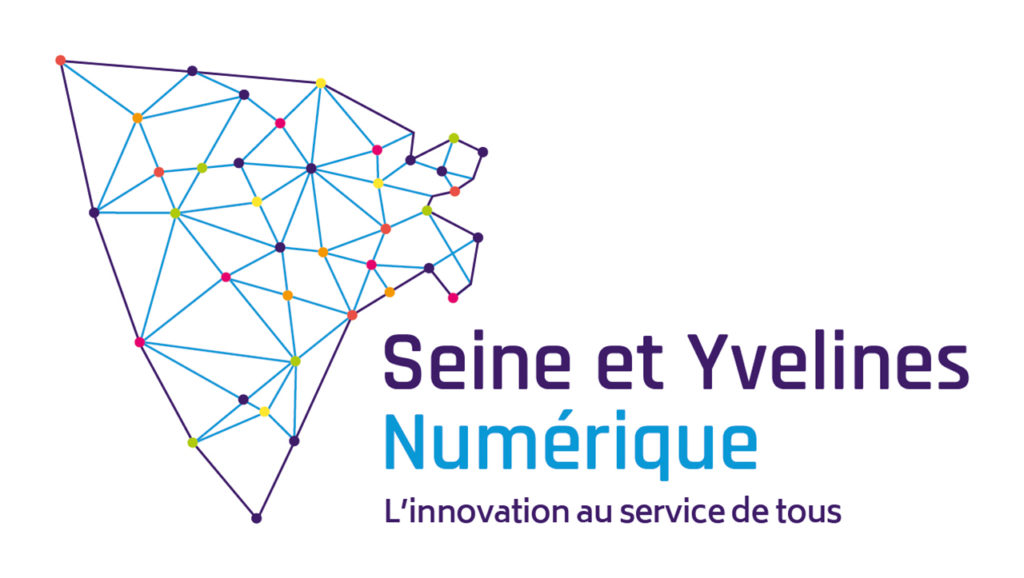
Background
Seine-et-Yvelines Numérique has a relatively short history. Originally attached solely to the County of Yvelines when it was first established in 2016, the Open Mixed Syndicate (“Syndicat Mixte Ouvert” - SMO) became known as Seine-et-Yvelines Numérique in January 2020 with the membership of the county of Hauts-De-Seine.
They’ve managed to do a lot in a short amount of time. Seine-et-Yvelines Numérique was created to organize the deployment of Very High Speed internet (THD) and develop digital services throughout the territory – including electronic security, IT and telecom solutions and digital education. They are currently managing technology for 116 colleges (students ages 11-15) in the Yvelines and are also responsible for the various municipalities that can subscribe to their educational offerings.
Ultimately, Seine-et-Yvelines Numérique wants students to use digital technology its fullest potential. This takes solid support from teachers and reliable device charging and security.
Challenge
Seine-et-Yvelines Numérique supports education players at all levels of technology: access to THD, turnkey hardware and software solutions, teacher technical training, and facilitation of educational projects. Each year, the colleges are asked to make calls for educational projects, which allow them access to additional digital equipment. Through these calls, Seine-et-Yvelines Numérique has seen the demand for mobile tablet classes rise dramatically.
With 16,000 iPads deployed in total (amongst which 4,400 iPads are deployed in carts as “mobile classrooms” ) throughout 96 colleges, Seine-et-Yvelines Numérique manages devices for a wide variety of uses: security when not in use, charging without degrading the batteries, and easily transporting devices up and down stairs and across college campuses that may be spread out over several buildings.
Solution
Seine-et-Yvelines Numérique first saw LocknCharge products at the Bett Education Technology Show and knew immediately that the Carrier™ Charging Carts were the right fit for their teachers. The heavy-duty, fully welded steel Carts would secure 20, 30 or 40 mobile devices, and with the option to use Baskets by LocknCharge inside the Carts, the colleges are given ultimate flexibility with their device deployments.
The SMO purchased hundreds of Carrier Carts to use throughout the county colleges. As Seine-et-Yvelines Numérique’s Mobility Project Manager, Patrick Mazars, put it,
“The complexity of deploying the devices is no longer an obstacle to using these devices.”
He explained that teachers are impressed with the carts because of their Swiss-Army-knife-like versatility. Whether sharing 30 iPads between classrooms or grabbing a Basket of 5, they are equipped to do it quickly and safely.
Another notable feature of the Carrier Carts is the ECO Safe Charge™ Power Management System, built to handle power requirements of almost any device by staging the availability of power. The system also ensures that devices are not overcharged, increasing their longevity.
Patrick Mazars and his team compared all other carts available on the market, and LocknCharge came out on top to best fit the requirements of the customer. Even after in-depth research, they were pleasantly surprised to discover another advantage when the Carts arrived–how easy they were to plug and unplug.
“It’s very simple, it’s effective,” Patrick Mazars said.
Effectiveness is important to Seine-et-Yvelines Numérique. They’ve taken careful, calculated action to make sure their colleges and municipalities maximize the use of their digital technology. They’re not deploying equipment recklessly without thought or training, but rather little by little with proper support.
What’s Next?
As more and more teachers witness the ease in which their colleagues are adopting and deploying mobile technology into the classrooms with the help of LocknCharge solutions, more and more teachers are utilizing and requesting them. The charging and storage solutions have become a well-known and necessary component to the full mobile device package. Even municipalities are convinced that you can’t have one without the other.
Seine-et-Yvelines Numérique plans to add more Carrier 20, 30 and 40 Carts, iQ 10 and Putnam 16 Charging Stations, and FUYL Towers in the near term.
Download a PDF of this story.
Want to learn more?
Schedule a Live Product Demo
Schedule a live video demo with a LocknCharge team member to get a closer look at how our products help make your life easier.

